In a sense two Ku Klux Klans existed in Fort Worth during the organization’s heyday in the 1920s—two Klans that were as different as, well, day and night. The daytime Klan gave money to charities and churches and helped needy widows. The nighttime Klan intimidated, tarred and feathered, and lynched those people whom it deemed deserving of its hooded vigilante justice.
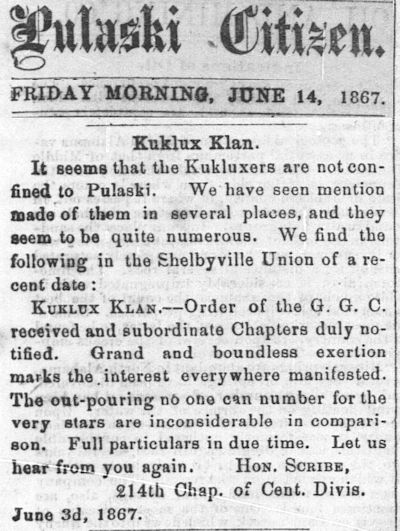 Some background: The original Ku Klux Klan was founded in Pulaski, Tennessee in December 1865 during Reconstruction. In the beginning the Pulaski Citizen dutifully printed the Klan’s notices and handbills announcing meetings, parades, and such but all the while snickered at the Klan’s costumes, rituals, and lofty titles for officers. By 1867 the Pulaski newspaper noted that the “Kukluxers” were spreading.
Some background: The original Ku Klux Klan was founded in Pulaski, Tennessee in December 1865 during Reconstruction. In the beginning the Pulaski Citizen dutifully printed the Klan’s notices and handbills announcing meetings, parades, and such but all the while snickered at the Klan’s costumes, rituals, and lofty titles for officers. By 1867 the Pulaski newspaper noted that the “Kukluxers” were spreading.
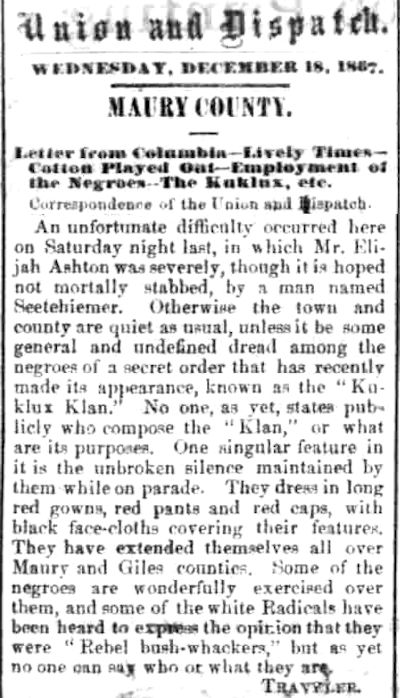 During Reconstruction the Klan targeted freedmen and sought to restore—by intimidation and violence—white supremacy. In 1867 the Nashville Union and Dispatch reported “some general and undefined dread among the negroes of a secret order that has recently made its appearance.”
During Reconstruction the Klan targeted freedmen and sought to restore—by intimidation and violence—white supremacy. In 1867 the Nashville Union and Dispatch reported “some general and undefined dread among the negroes of a secret order that has recently made its appearance.”
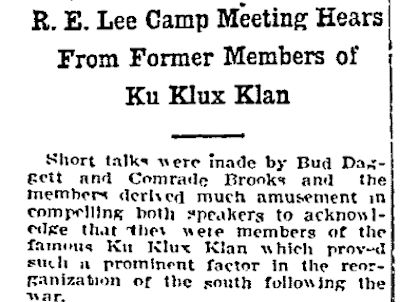 Fast-forward to Fort Worth in 1908. Fort Worth businessman E. B. “Bud” Daggett (1838-1911) acknowledged having been a member of the Klan during its first incarnation. Daggett—named for his father, Ephraim Merrell, the “father of Fort Worth”—fathered a son by a Daggett plantation African-American slave. The Robert E. Lee Camp was a local Confederate veterans group. Clip is from the June 8 Telegram.
Fast-forward to Fort Worth in 1908. Fort Worth businessman E. B. “Bud” Daggett (1838-1911) acknowledged having been a member of the Klan during its first incarnation. Daggett—named for his father, Ephraim Merrell, the “father of Fort Worth”—fathered a son by a Daggett plantation African-American slave. The Robert E. Lee Camp was a local Confederate veterans group. Clip is from the June 8 Telegram.
The second Ku Klux Klan was founded in 1915 in Atlanta, Georgia as America coped with its evolution from a rural agricultural culture to an urban industrial culture and responded to developments such as immigration and prohibition. The second Klan’s appeal to PAMs (Protestant Anglo males) was considerable, especially in the South. In the 1920s an estimated four to five million PAMs were members (U.S. population in 1920 was 106 million) as the Klan crusaded for “one hundred percent Americanism,” the purification of politics, strict morality, and enforcement of prohibition. The Klan, while still stressing white supremacy, moved beyond targeting African Americans to include Catholics, Jews, and foreigners.
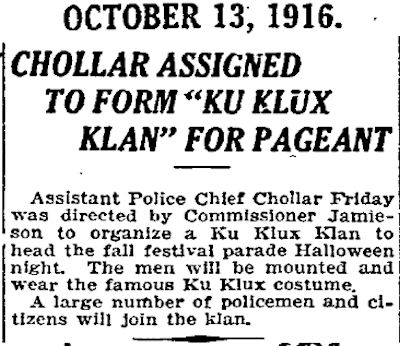 The Klan in Fort Worth was organized in 1916 when Police Commissioner Hugh Jamieson directed Assistant Police Chief George Chollar “to organize a Ku Klux Klan to head the fall festival parade Halloween night.” Retired Fort Worth police sergeant and historian Kevin Foster writes, “George Chollar followed his instructions and in time for the parade, Chollar had a group of local men inducted into the Klan. Most, if not all of these men were Fort Worth police officers. On the night of the Halloween parade, Mayor Tyra took the lead along with Commissioner Jamieson and a small group of uniformed police officers. They were followed by a group of Klansmen, wearing their robes and hoods and riding on horseback.”
The Klan in Fort Worth was organized in 1916 when Police Commissioner Hugh Jamieson directed Assistant Police Chief George Chollar “to organize a Ku Klux Klan to head the fall festival parade Halloween night.” Retired Fort Worth police sergeant and historian Kevin Foster writes, “George Chollar followed his instructions and in time for the parade, Chollar had a group of local men inducted into the Klan. Most, if not all of these men were Fort Worth police officers. On the night of the Halloween parade, Mayor Tyra took the lead along with Commissioner Jamieson and a small group of uniformed police officers. They were followed by a group of Klansmen, wearing their robes and hoods and riding on horseback.”
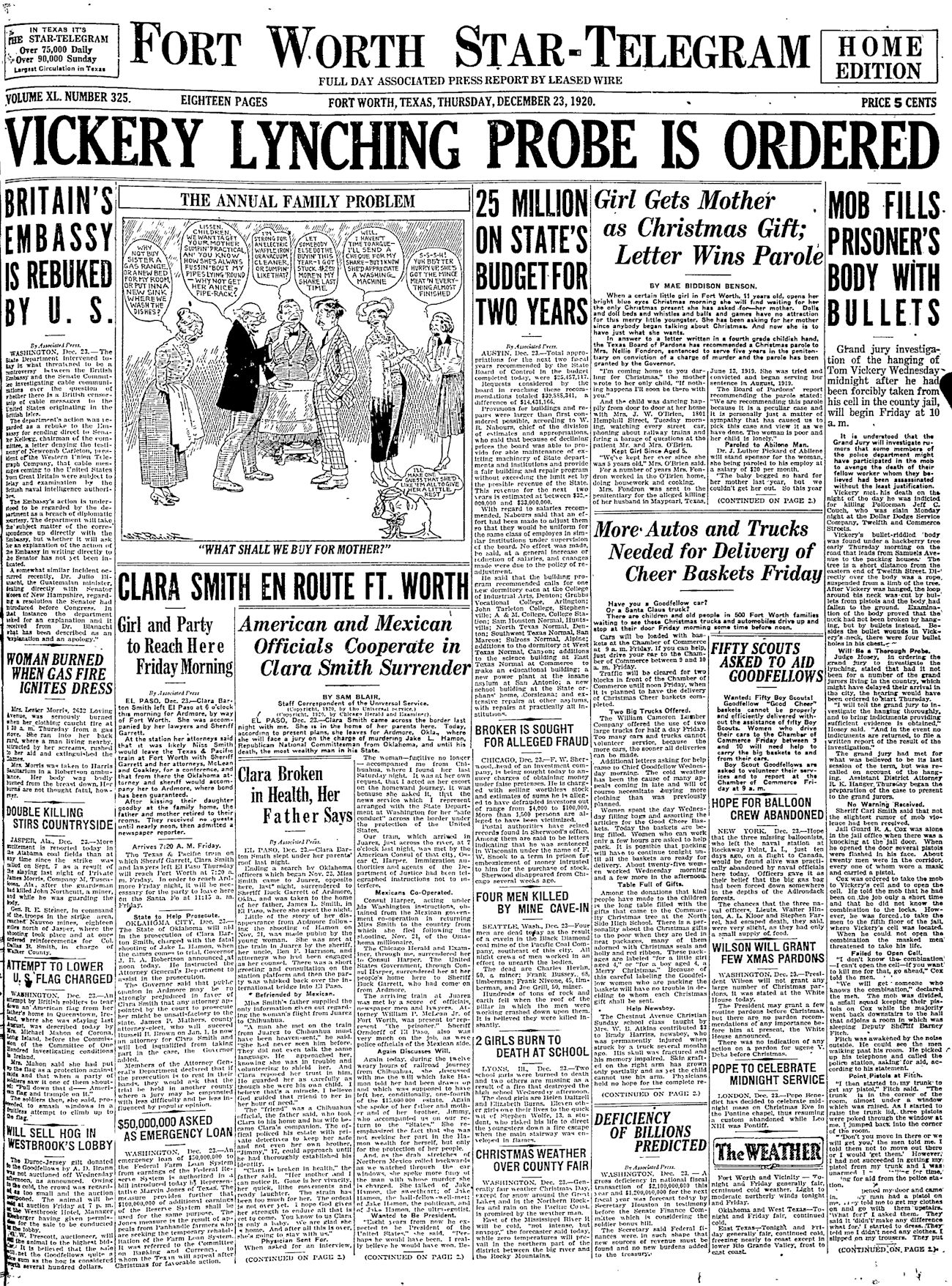 The Fort Worth Klan in the beginning kept itself out of the headlines for the most part. But there were rumors. For example, on December 22, 1920 a mob of twenty men, each of whom wore a mask and carried a pistol, forcibly removed prisoner Tom Vickery from his cell in the county jail. Vickery had been jailed for the shooting death of police officer Jeff C. Couch.
The Fort Worth Klan in the beginning kept itself out of the headlines for the most part. But there were rumors. For example, on December 22, 1920 a mob of twenty men, each of whom wore a mask and carried a pistol, forcibly removed prisoner Tom Vickery from his cell in the county jail. Vickery had been jailed for the shooting death of police officer Jeff C. Couch.
The mob took Vickery to the “hanging tree” on Northeast 12th Street and lynched him. The mob then riddled his body with bullets. The mob was rumored to be made up of Klansmen, including police officers seeking revenge on Vickery. Two grand juries failed to indict anyone for the lynching.
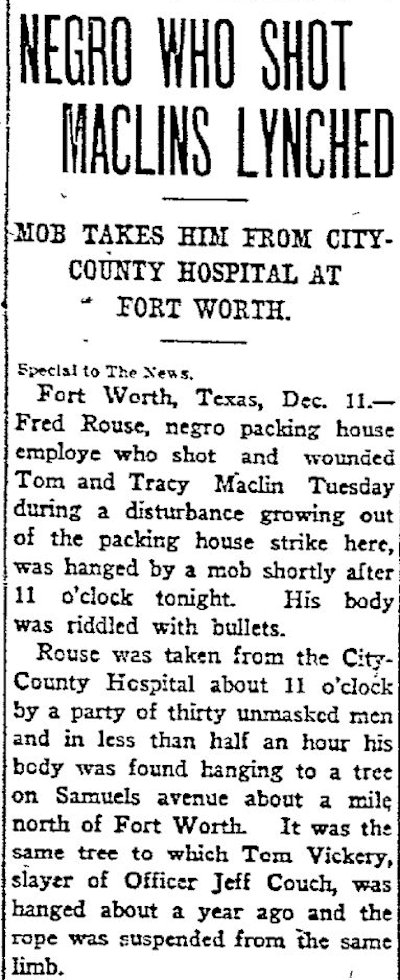 A year later African-American laborer Fred D. Rouse, who had been hospitalized after being beaten during a confrontation with striking packing plant workers, was forcibly taken from his hospital bed by a mob of at least twenty-five men (some wearing handkerchiefs over their faces) and hanged at the same tree. Again, the Klan and police officers (especially officers of Niles City) were rumored to be responsible. And again, no one was ever convicted.
A year later African-American laborer Fred D. Rouse, who had been hospitalized after being beaten during a confrontation with striking packing plant workers, was forcibly taken from his hospital bed by a mob of at least twenty-five men (some wearing handkerchiefs over their faces) and hanged at the same tree. Again, the Klan and police officers (especially officers of Niles City) were rumored to be responsible. And again, no one was ever convicted.
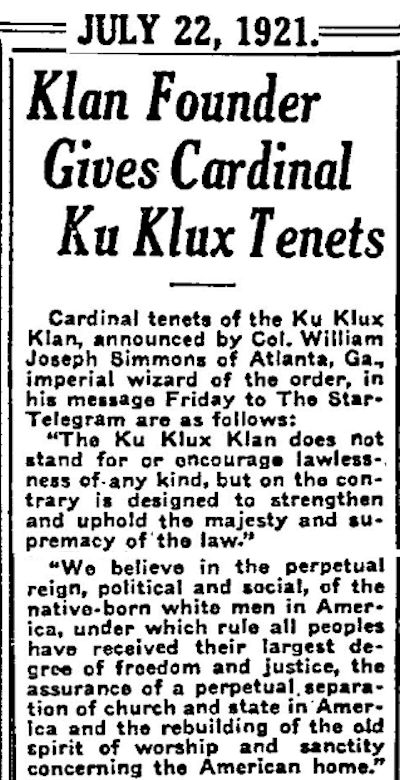 That same year, 1921, Colonel William Joseph Simmons, leader of the national Klan, proclaimed the organization’s tenets, among them “the perpetual reign . . . of the native-born white men in America.”
That same year, 1921, Colonel William Joseph Simmons, leader of the national Klan, proclaimed the organization’s tenets, among them “the perpetual reign . . . of the native-born white men in America.”
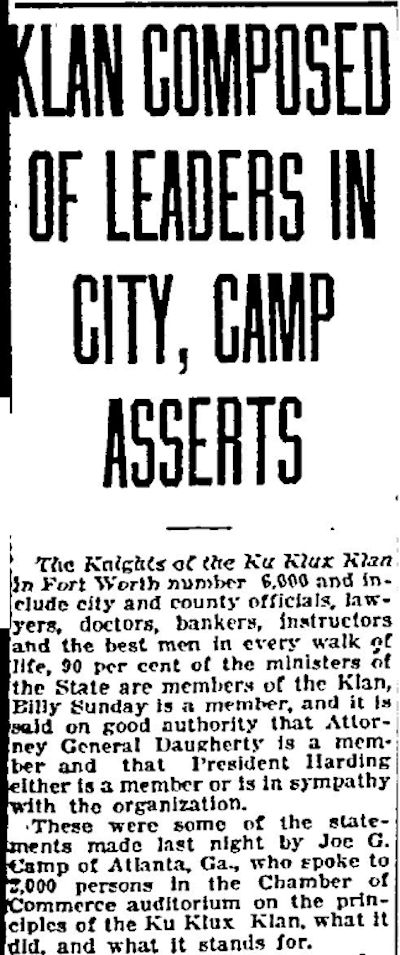 By 1922 the Fort Worth Klan, which had evolved into Klavern (lodge) no. 101, was one of the strongest Klans in the country. The local Klan had members among civic leaders, city government, clergy, and teachers in addition to police officers, local historians say. In 1922 a Klan lecturer said Fort Worth had six thousand Klan members, including “the best men in every walk of life.” Many Klan members belonged to fraternal organizations such as Moslah Shrine and Knights of Pythias. (Fort Worth’s population in 1920 was 106,482.) Clip is from the April 23, 1922 Star-Telegram.
By 1922 the Fort Worth Klan, which had evolved into Klavern (lodge) no. 101, was one of the strongest Klans in the country. The local Klan had members among civic leaders, city government, clergy, and teachers in addition to police officers, local historians say. In 1922 a Klan lecturer said Fort Worth had six thousand Klan members, including “the best men in every walk of life.” Many Klan members belonged to fraternal organizations such as Moslah Shrine and Knights of Pythias. (Fort Worth’s population in 1920 was 106,482.) Clip is from the April 23, 1922 Star-Telegram.
In fact, in 1922 two Metroplex men—Dr. Hiram Wesley Evans of Dallas and Brown Harwood of Fort Worth—were elected to the top two offices of the national Klan. Evans succeeded William Joseph Simmons.
 The Ku Klux Klan called itself the “Invisible Empire,” but in Fort Worth it was quite visible, at least by day. When city finance commissioner W. B. Townsend died in 1923, his funeral included what the Dallas Morning News on September 20 called the “first Ku Klux Klan funeral parade ever held.”
The Ku Klux Klan called itself the “Invisible Empire,” but in Fort Worth it was quite visible, at least by day. When city finance commissioner W. B. Townsend died in 1923, his funeral included what the Dallas Morning News on September 20 called the “first Ku Klux Klan funeral parade ever held.”
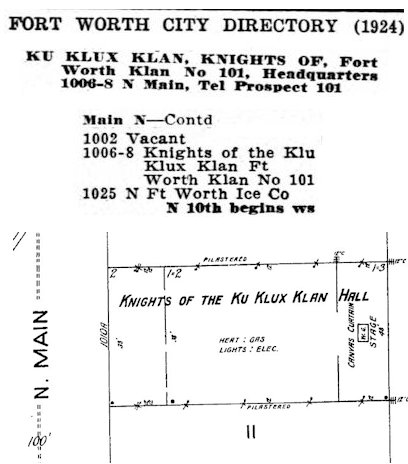 Nor was the Klan secretive about the location of its lodge hall. The 1924 city directory listed the Klan’s address on North Main Street. The lodge hall was labeled on the 1926 Sanborn map.
Nor was the Klan secretive about the location of its lodge hall. The 1924 city directory listed the Klan’s address on North Main Street. The lodge hall was labeled on the 1926 Sanborn map.
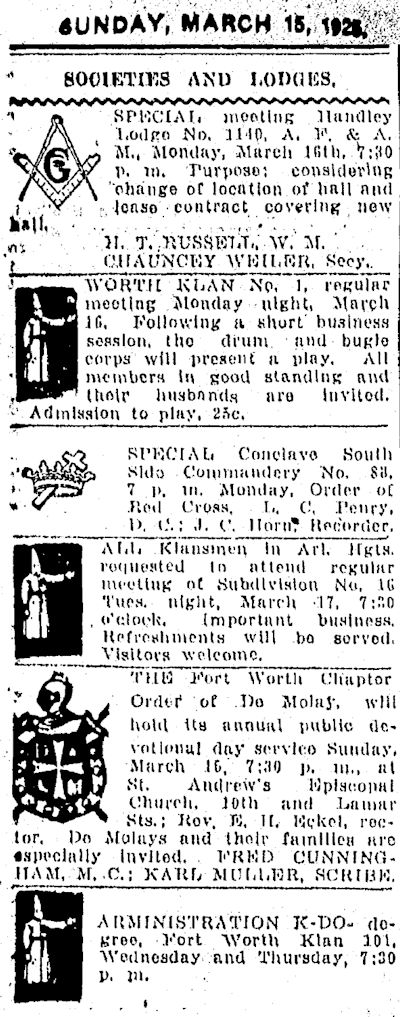 In 1925 the Fort Worth Klan posted notices of its meetings in newspaper classified ads just as did fraternal organizations such as Masons, Order of the Red Cross of Freemasonry, and De Molay.
In 1925 the Fort Worth Klan posted notices of its meetings in newspaper classified ads just as did fraternal organizations such as Masons, Order of the Red Cross of Freemasonry, and De Molay.
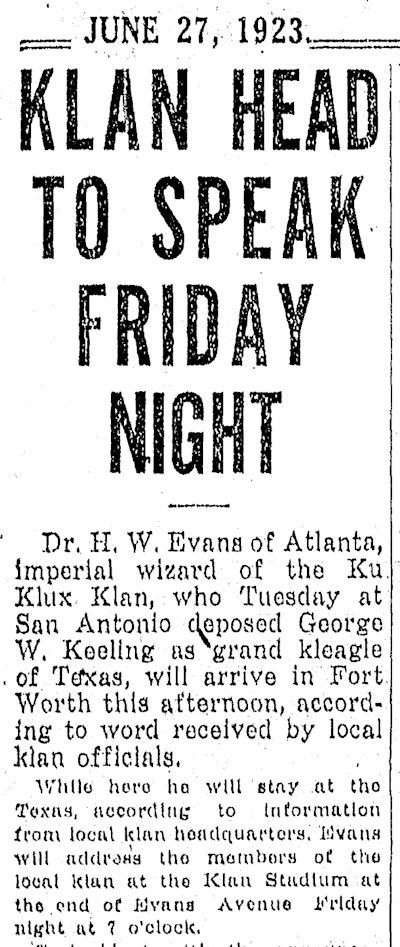 By 1923 Dr. Hiram Wesley Evans had moved from Dallas to Atlanta to head the national organization. According to this article, the Fort Worth Klan had a stadium “at the end of Evans Avenue.” In 1923 that would have been an undeveloped area north of Echo Lake.
By 1923 Dr. Hiram Wesley Evans had moved from Dallas to Atlanta to head the national organization. According to this article, the Fort Worth Klan had a stadium “at the end of Evans Avenue.” In 1923 that would have been an undeveloped area north of Echo Lake.
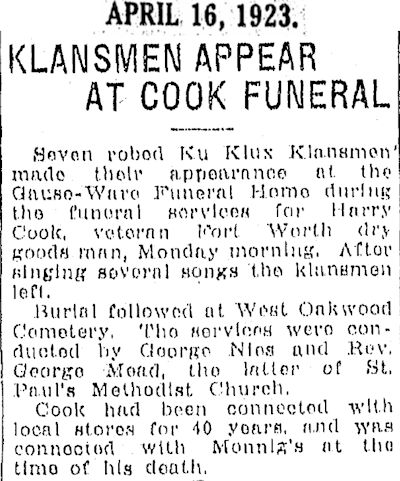 In yet another indication of their openness in the early 1920s, Klan members even attended funerals in their robes (and sang!).
In yet another indication of their openness in the early 1920s, Klan members even attended funerals in their robes (and sang!).
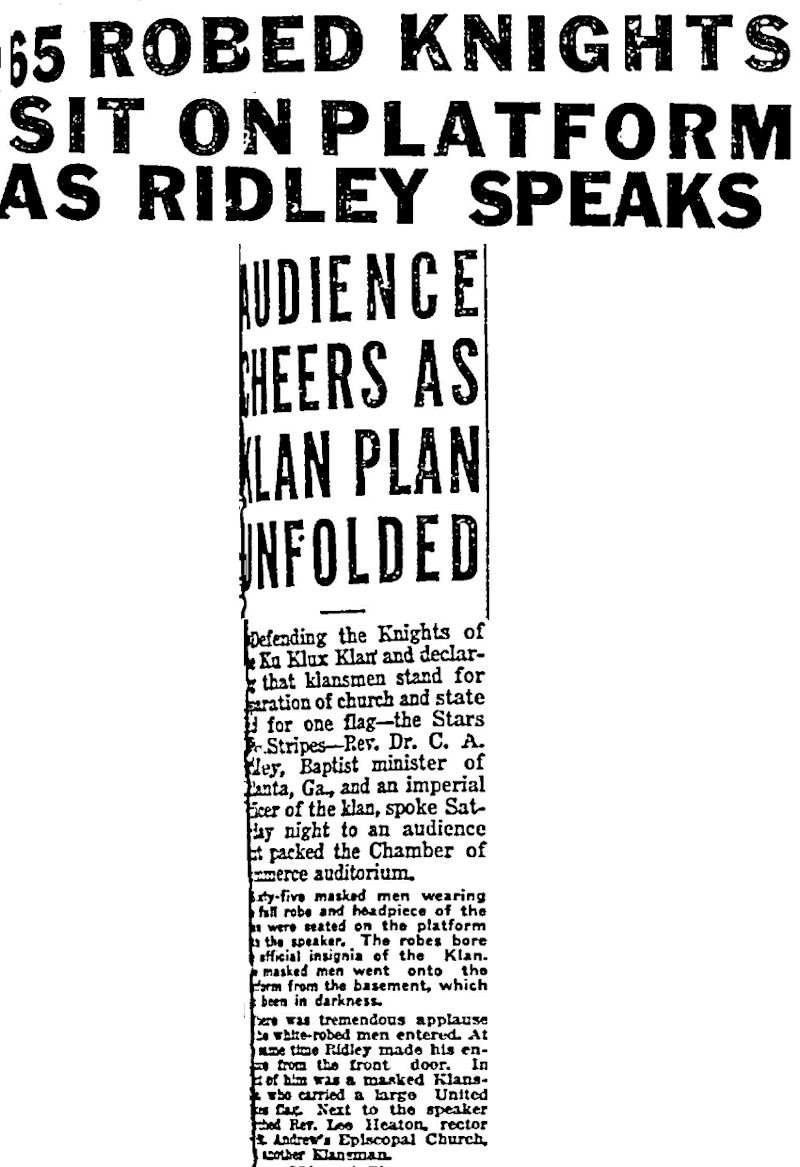
On August 14, 1921 the Star-Telegram reported that the Reverend Caleb A. Ridley, chaplain of the national Klan, had spoken to an enthusiastic audience in the auditorium of the Chamber of Commerce. The Reverend Lee Heaton of St. Andrew Episcopal Church introduced Ridley and sat next to him on the stage along with sixty-five masked men.
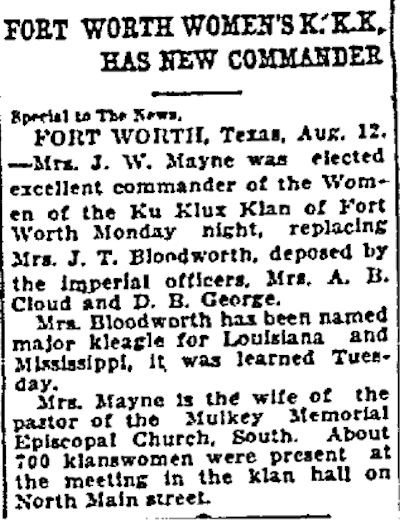 The Fort Worth Klan also had a women’s auxiliary. Mrs. Joseph T. Bloodworth also was president of the local Woman’s Christian Temperance Union and Church Women’s Federation.
The Fort Worth Klan also had a women’s auxiliary. Mrs. Joseph T. Bloodworth also was president of the local Woman’s Christian Temperance Union and Church Women’s Federation.

Mr. and Mrs. Joseph T. Bloodworth were the parents of Lloyd P. Bloodworth, grand dragon of the Texas KKK and a member of First Baptist Church. Father and son were evangelists living within a few blocks of each other in Poly. Clip is from the August 23, 1924 Dallas Morning News.
 (Mrs. Bloodworth’s women’s groups also opposed “parading in bathing suits” at Lake Worth and smashed some bootleg whiskey behind the courthouse. Clips are from the July 22, 1921 and March 26, 1929 Dallas Morning News.)
(Mrs. Bloodworth’s women’s groups also opposed “parading in bathing suits” at Lake Worth and smashed some bootleg whiskey behind the courthouse. Clips are from the July 22, 1921 and March 26, 1929 Dallas Morning News.)
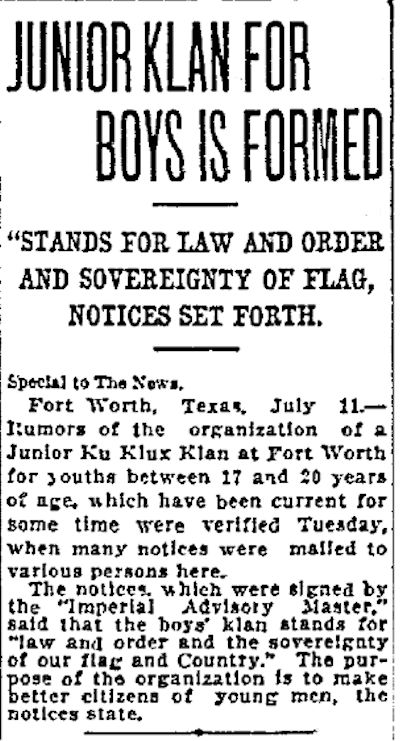 The Fort Worth Klan also had a Junior KKK for boys between the ages of seventeen and twenty. Clip is from the July 12, 1922 Dallas Morning News.
The Fort Worth Klan also had a Junior KKK for boys between the ages of seventeen and twenty. Clip is from the July 12, 1922 Dallas Morning News.
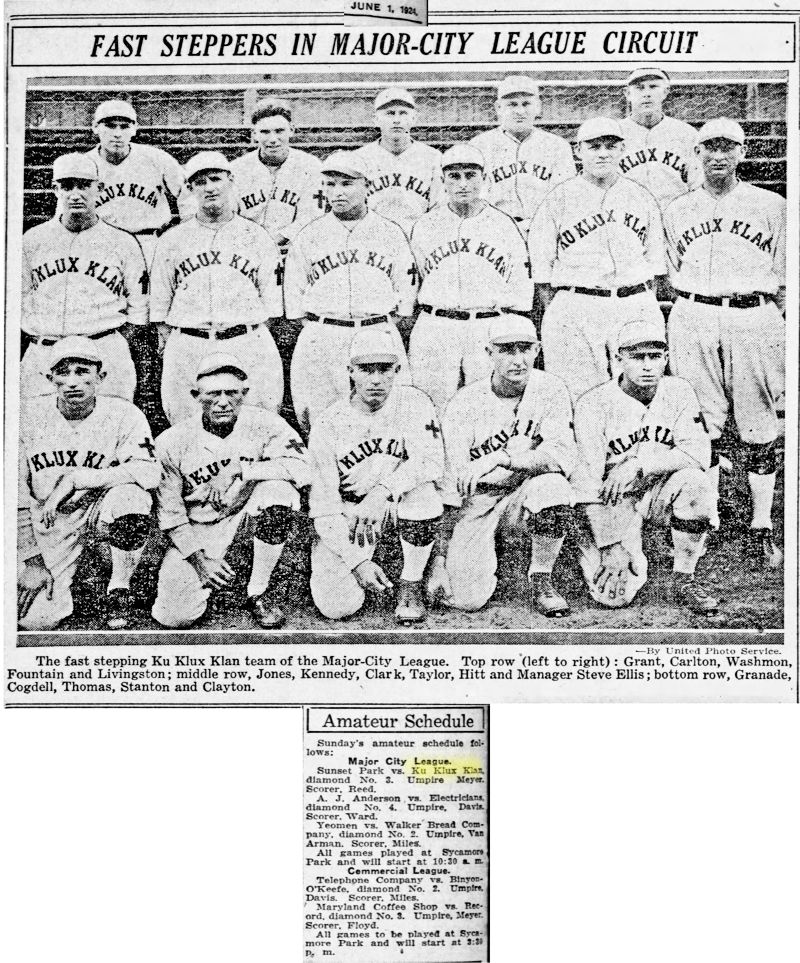 In 1924 the Fort Worth Klan had a baseball team that played in the Major City League at Sycamore Park.
In 1924 the Fort Worth Klan had a baseball team that played in the Major City League at Sycamore Park.
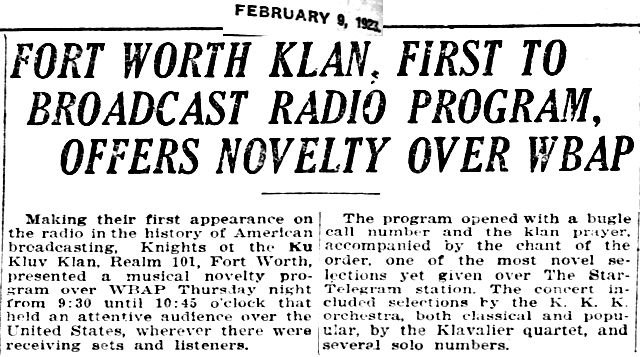 And, yes, the Fort Worth Klan had an orchestra. In 1923 the local Klan presented a musical novelty program on WBAP radio. The Klan orchestra performed Handel’s “Joy to the World,” Schubert’s “Serenade,” and “Toot, Toot, Tootsie.”
And, yes, the Fort Worth Klan had an orchestra. In 1923 the local Klan presented a musical novelty program on WBAP radio. The Klan orchestra performed Handel’s “Joy to the World,” Schubert’s “Serenade,” and “Toot, Toot, Tootsie.”
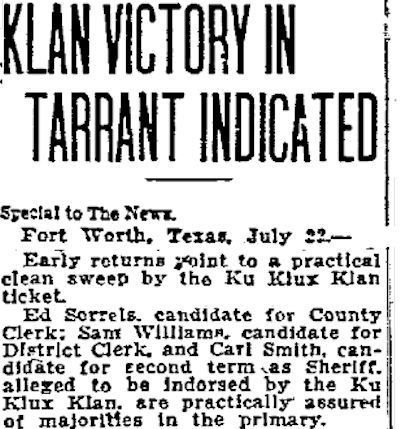 The Fort Worth Klan, not surprisingly, was political, endorsing candidates for local office. Clip is from the July 23, 1922 Dallas Morning News. That year the Klan also fielded a Democratic candidate—Earle B. Mayfield—for the U.S. Senate seat of C. A. Culberson. Mayfield was elected.
The Fort Worth Klan, not surprisingly, was political, endorsing candidates for local office. Clip is from the July 23, 1922 Dallas Morning News. That year the Klan also fielded a Democratic candidate—Earle B. Mayfield—for the U.S. Senate seat of C. A. Culberson. Mayfield was elected.
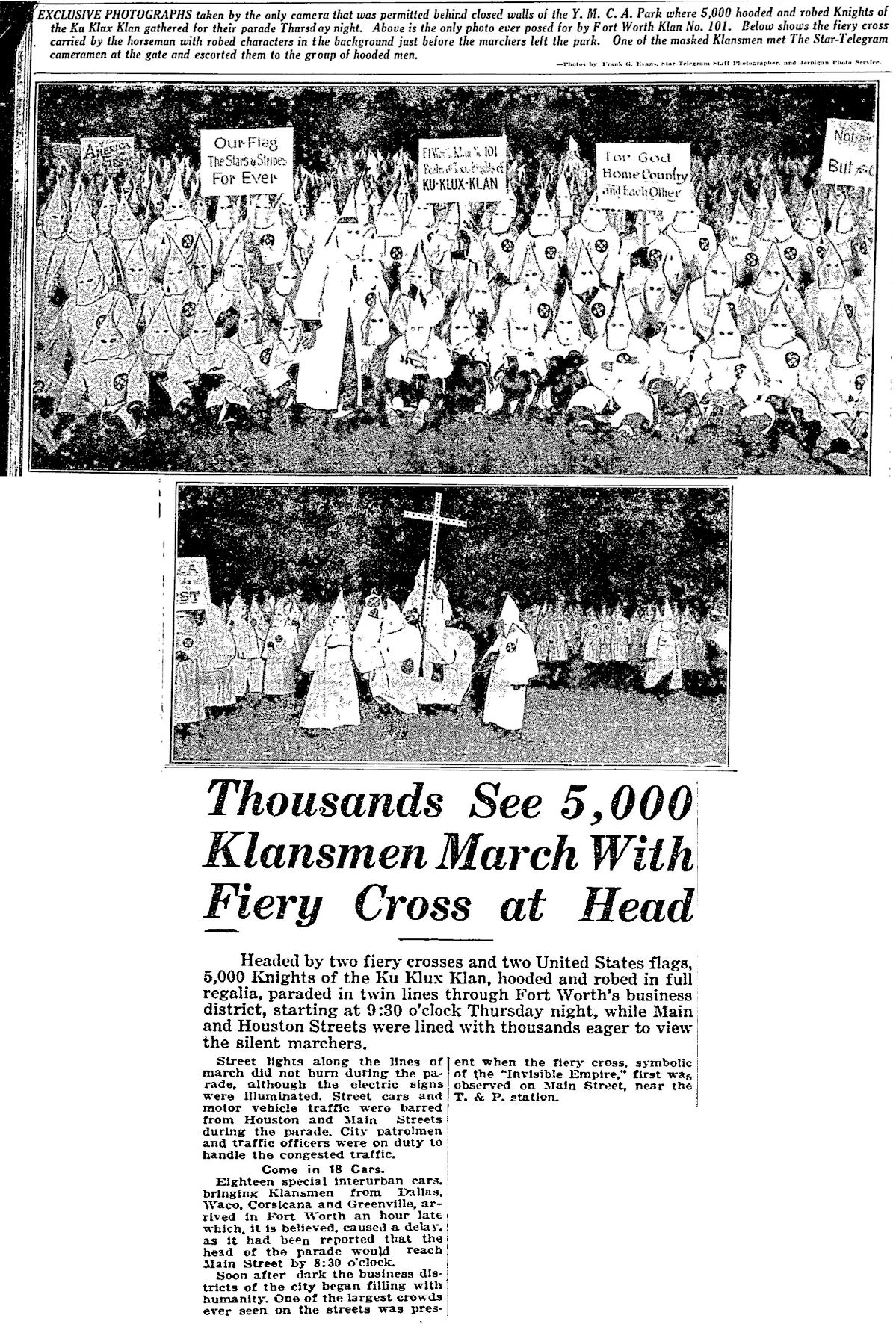 In February 1922 five thousand Klansmen from north Texas marched in downtown Fort Worth. Special interurban cars brought in Klansmen from Dallas, Waco, Corsicana, and Greenville. Clip is from the February 17 Star-Telegram.
In February 1922 five thousand Klansmen from north Texas marched in downtown Fort Worth. Special interurban cars brought in Klansmen from Dallas, Waco, Corsicana, and Greenville. Clip is from the February 17 Star-Telegram.

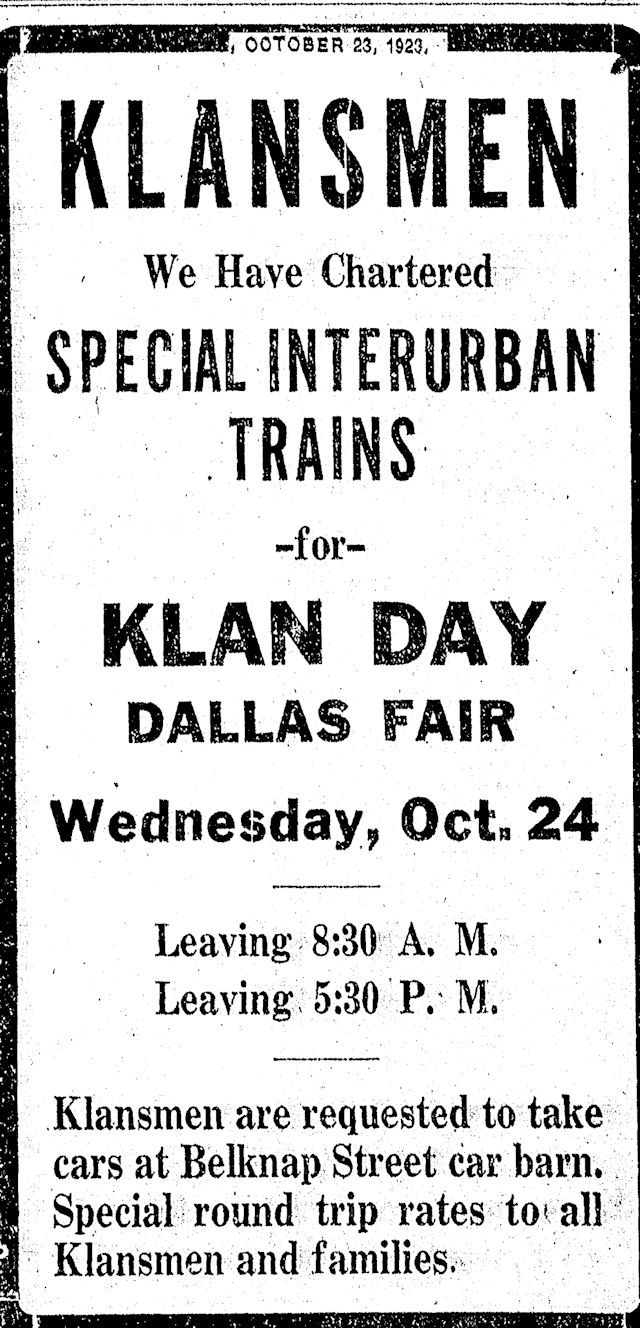 In Dallas the state fair and in Fort Worth the stock show designated “Klan Day.” The interurban offered special rates to Dallas for “all Klansmen and families.”
In Dallas the state fair and in Fort Worth the stock show designated “Klan Day.” The interurban offered special rates to Dallas for “all Klansmen and families.”
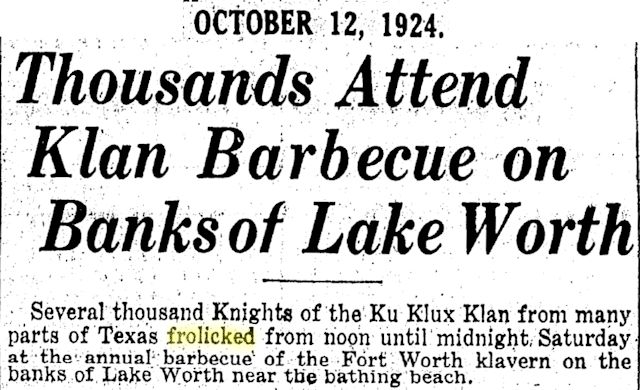 Now here’s a mental image: Klan members “frolicking” at Lake Worth.
Now here’s a mental image: Klan members “frolicking” at Lake Worth.
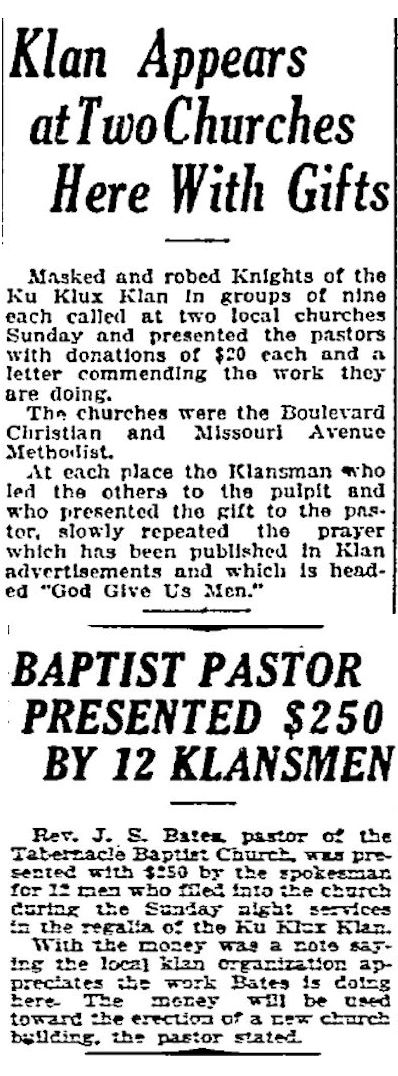 By day the Fort Worth Klan supported local churches. These clips are from the October 23 and December 11, 1922 Star-Telegram.
By day the Fort Worth Klan supported local churches. These clips are from the October 23 and December 11, 1922 Star-Telegram.
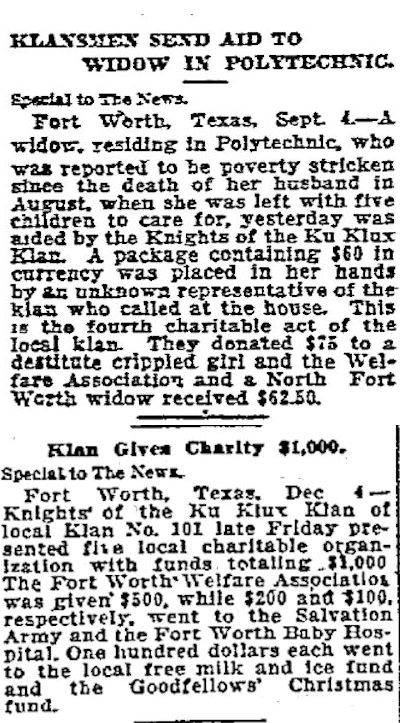 Here are more examples of the local Klan’s daytime charity. Clips are from the September 5 and December 5, 1921 Star-Telegram.
Here are more examples of the local Klan’s daytime charity. Clips are from the September 5 and December 5, 1921 Star-Telegram.
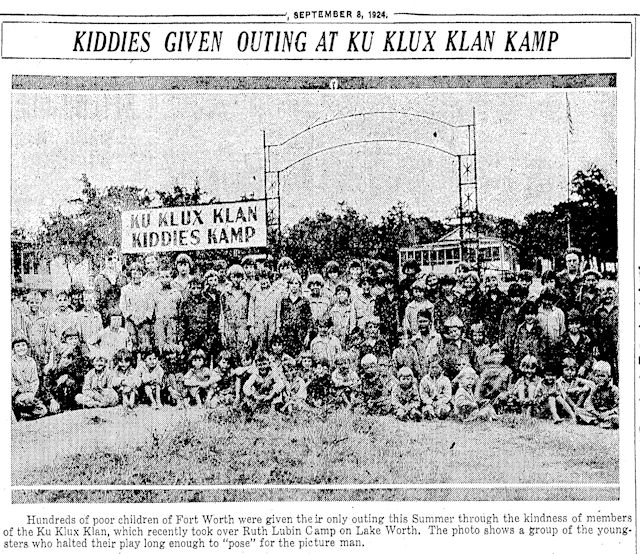 And the Klan sponsored a summer camp for poor children at Lake Worth.
And the Klan sponsored a summer camp for poor children at Lake Worth.
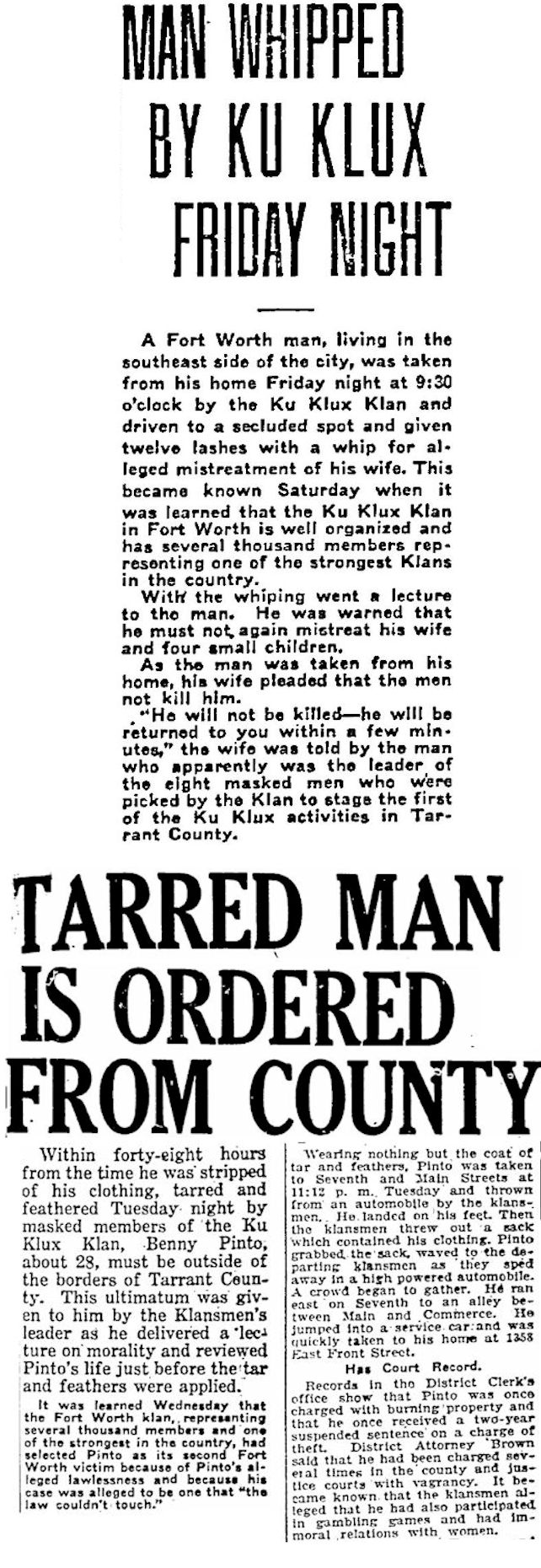 But when the sun went down the Fort Worth Klan traded hats for hoods and good deeds for dark deeds. In the top clip a husband was whipped for abusing his wife. In the bottom clip Benny Pinto, a grocery clerk, was fitted for a suit of tar and feathers and dumped at the intersection of Main and 7th streets for gambling and having immoral relations with women. The report says that the Fort Worth Klan, with “several thousand” members, was “one of the strongest in the country.”
But when the sun went down the Fort Worth Klan traded hats for hoods and good deeds for dark deeds. In the top clip a husband was whipped for abusing his wife. In the bottom clip Benny Pinto, a grocery clerk, was fitted for a suit of tar and feathers and dumped at the intersection of Main and 7th streets for gambling and having immoral relations with women. The report says that the Fort Worth Klan, with “several thousand” members, was “one of the strongest in the country.”
Victim Benny Pinto would quickly do as he had been ordered: He left the county.
These two victims were white men. How do we know? Because had they had been African American, they would have been identified as such by the newspaper (if, indeed, their victimization would have been reported at all). These two attacks occurred in the same week. Clips are from the July 2 and 6, 1921 Star-Telegram.
 But the Klan was not too busy punishing white men to overlook black men. The April 3, 1921 Star-Telegram reported that Alexander Johnson, “negro, vagrant,” was whipped and branded in Dallas. The report said law enforcement probably would not investigate the attack. Johnson, the report said, had confessed to “improper relations with a white woman.” Said Dallas County Sheriff Dan Harston: “The men who attacked the negro were good citizens—I feel convinced—and I am satisfied with their treatment of him. He no doubt deserved it.”
But the Klan was not too busy punishing white men to overlook black men. The April 3, 1921 Star-Telegram reported that Alexander Johnson, “negro, vagrant,” was whipped and branded in Dallas. The report said law enforcement probably would not investigate the attack. Johnson, the report said, had confessed to “improper relations with a white woman.” Said Dallas County Sheriff Dan Harston: “The men who attacked the negro were good citizens—I feel convinced—and I am satisfied with their treatment of him. He no doubt deserved it.”
The Dallas Morning News said the attack was the first evidence of Klan violence in north Texas.
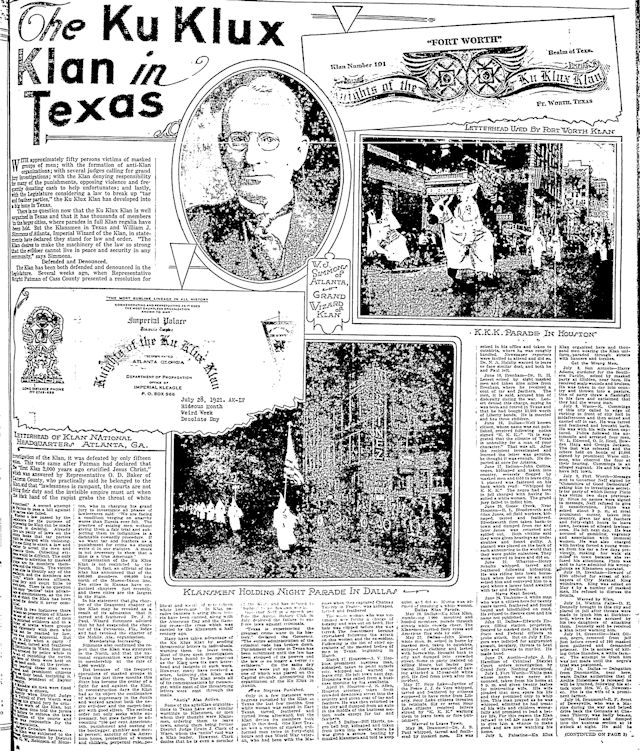 The revival of the Klan in Texas in the 1920s created controversy. On August 28, 1921 the Star-Telegram printed a full-page feature.
The revival of the Klan in Texas in the 1920s created controversy. On August 28, 1921 the Star-Telegram printed a full-page feature.
 An excerpt from the full-page feature.
An excerpt from the full-page feature.
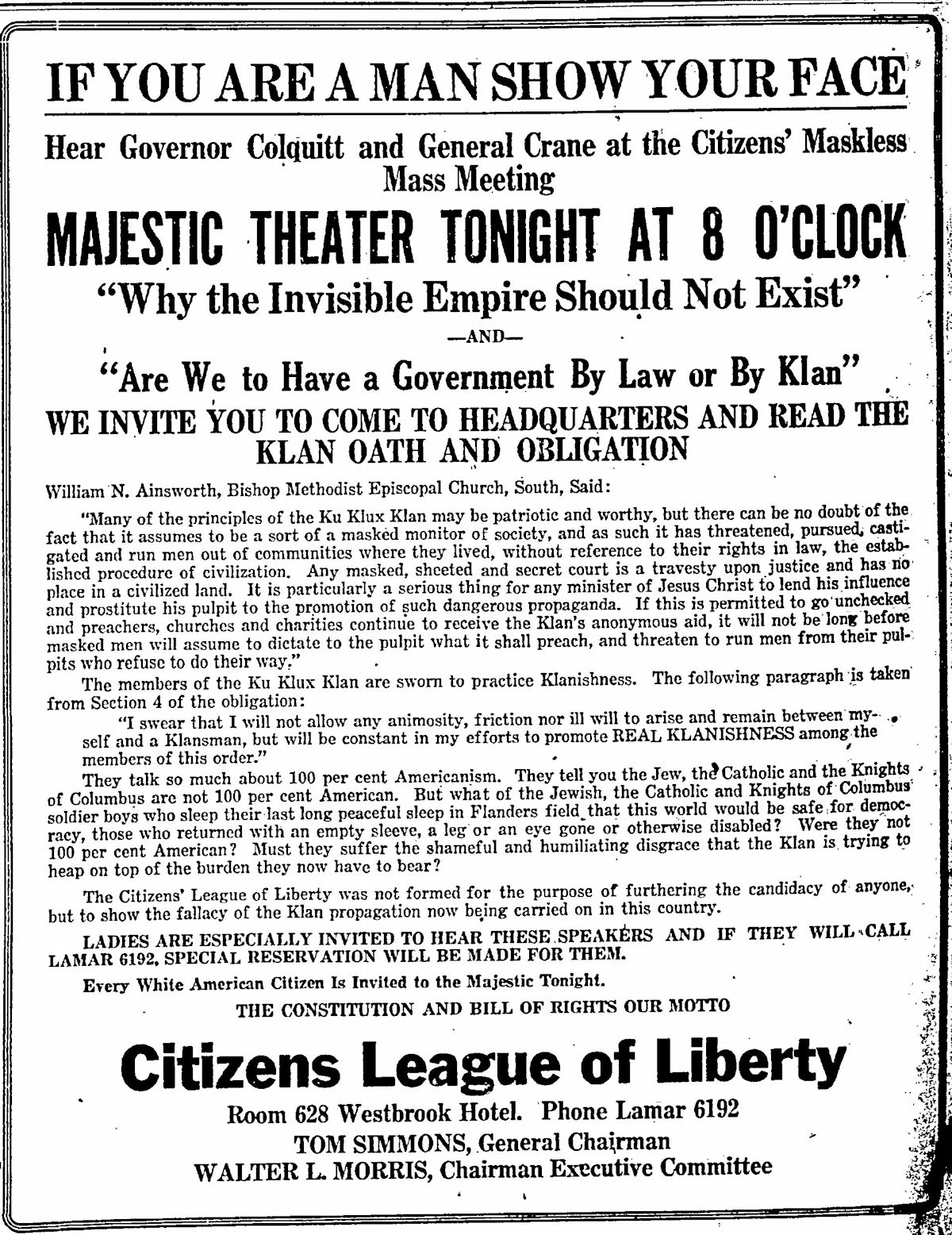 By 1922 the Klan’s violence had created a backlash. In Fort Worth the Citizens League of Liberty organized to oppose the KKK. This ad in the May 23, 1922 Star-Telegram promoted a public (i.e., “every white American citizen”) meeting whose topic would be “Why the Invisible Empire should not exist.” Among the speakers at the Majestic Theater would be former Governor Oscar Branch Colquitt.
By 1922 the Klan’s violence had created a backlash. In Fort Worth the Citizens League of Liberty organized to oppose the KKK. This ad in the May 23, 1922 Star-Telegram promoted a public (i.e., “every white American citizen”) meeting whose topic would be “Why the Invisible Empire should not exist.” Among the speakers at the Majestic Theater would be former Governor Oscar Branch Colquitt.
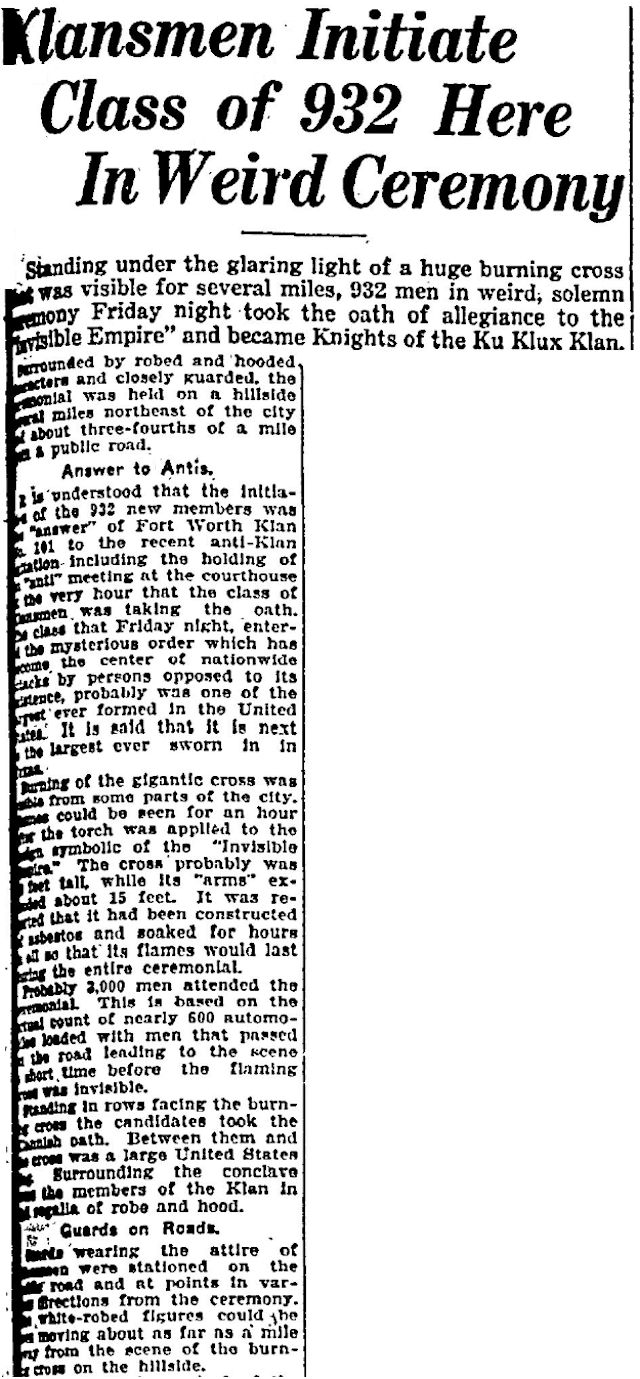 Just four days later, on May 27, 1922, the Star-Telegram reported that the local Klan “answered” the Citizens League of Liberty by initiating 932 new members in a “weird” ceremony that included burning a cross whose light was “visible for several miles.” The newspaper estimated that three thousand men attended the ceremony.
Just four days later, on May 27, 1922, the Star-Telegram reported that the local Klan “answered” the Citizens League of Liberty by initiating 932 new members in a “weird” ceremony that included burning a cross whose light was “visible for several miles.” The newspaper estimated that three thousand men attended the ceremony.
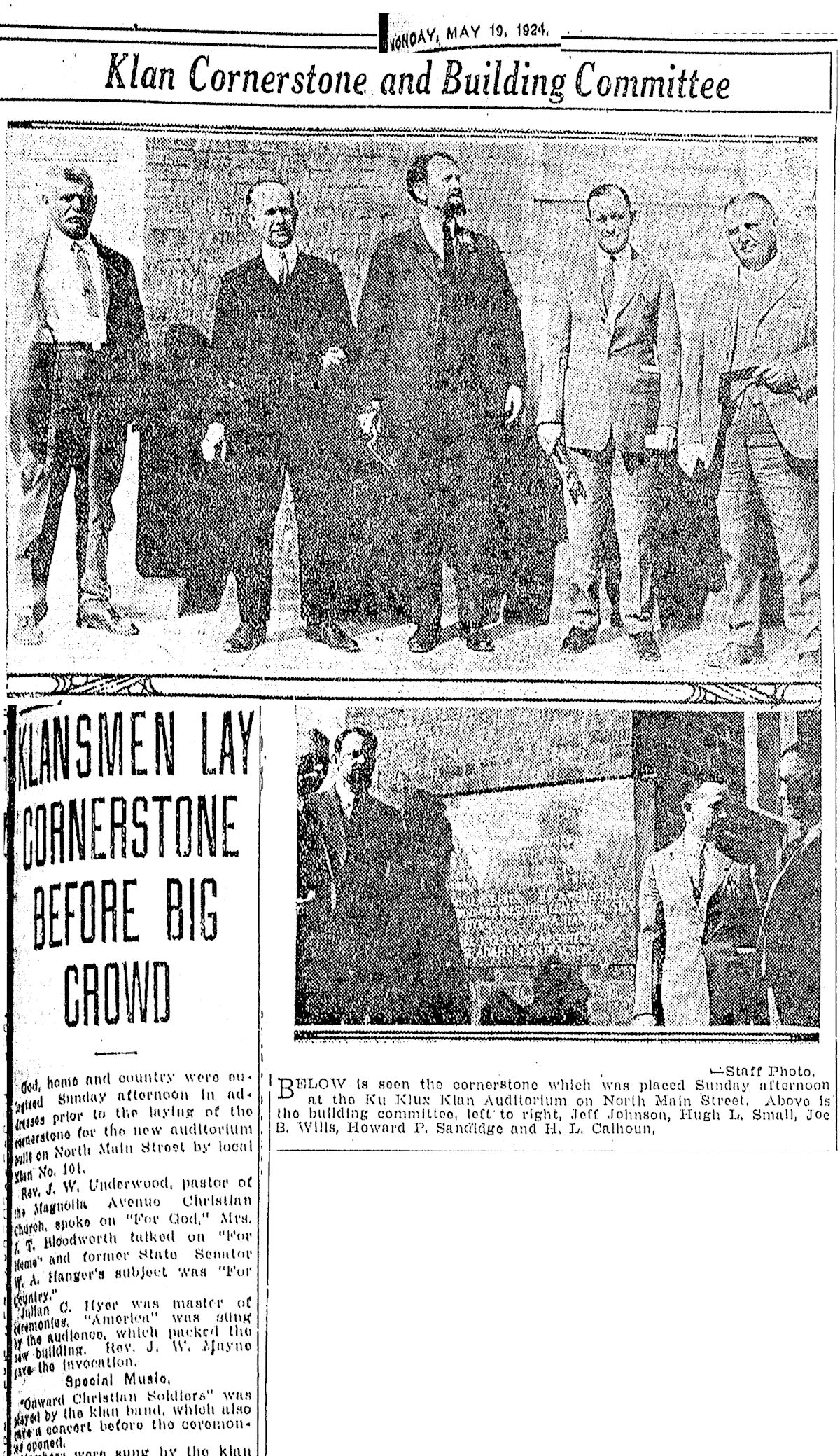 On May 19, 1924 Fort Worth’s Ku Klux Klan Lodge no. 101, its membership growing, laid the cornerstone of a new lodge hall at 1012 North Main Street. Two preachers, one state senator, and Mrs. Bloodworth participated. Topics of speakers at the dedication were “For God,” “For Home,” and “For Country.” The Klan band played “Onward, Christian Soldiers.”
On May 19, 1924 Fort Worth’s Ku Klux Klan Lodge no. 101, its membership growing, laid the cornerstone of a new lodge hall at 1012 North Main Street. Two preachers, one state senator, and Mrs. Bloodworth participated. Topics of speakers at the dedication were “For God,” “For Home,” and “For Country.” The Klan band played “Onward, Christian Soldiers.”
The new lodge hall’s auditorium, which seated two thousand, was used for Klan meetings, of course. But the hall also hosted outside entertainment. For example, on October 18, 1924 escape artist Harry Houdini mounted the hall stage to ask the question “Can the dead speak to the living?”
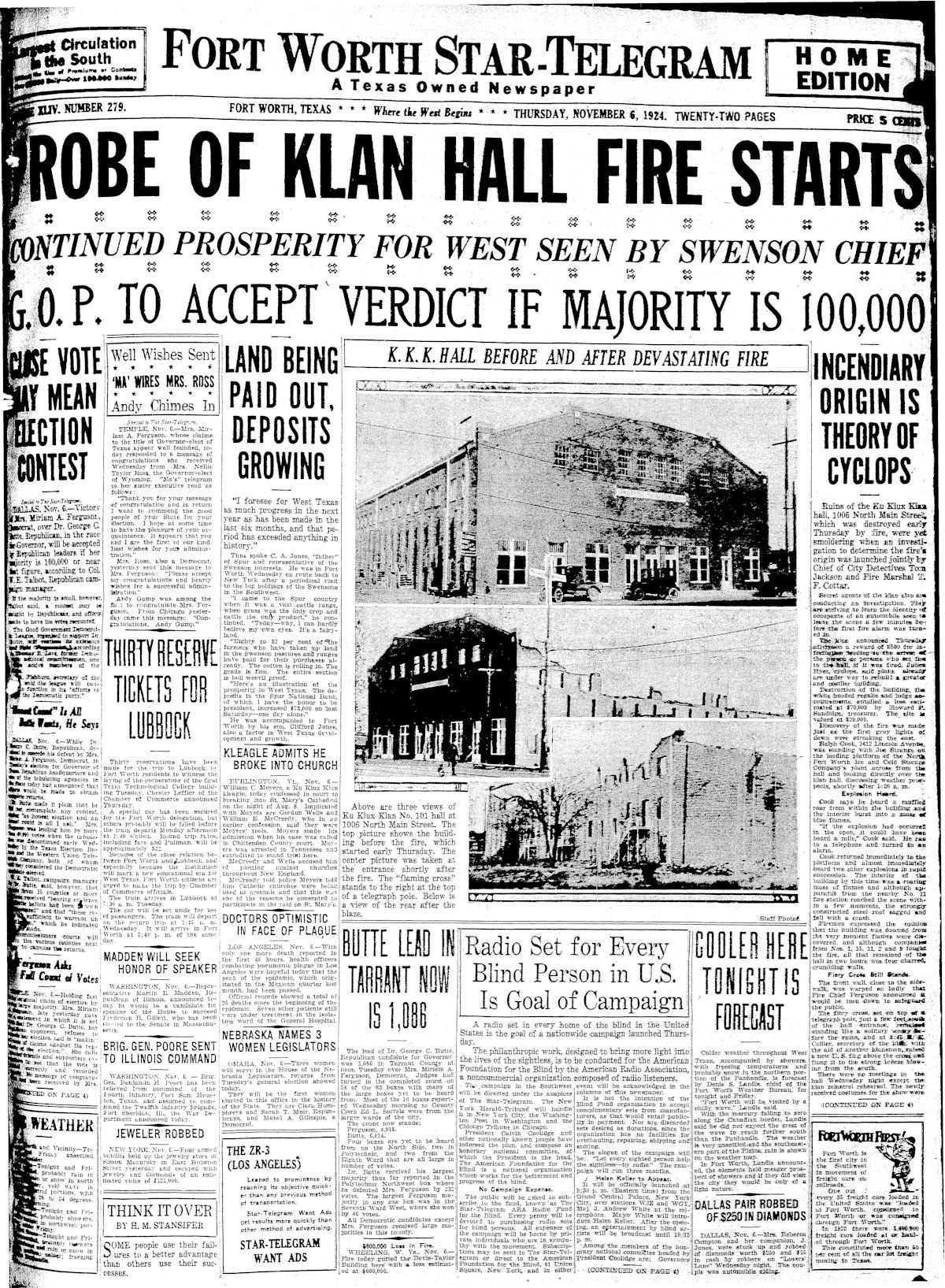
 But just three weeks later, on November 6, the new hall was destroyed by a fire. The front-page story mentions two officers of the local Klan: cyclops Julian C. Hyer and treasurer Howard P. Sandidge. Hyer was an attorney (and father of actress Martha Hyer); Sandidge was assistant cashier at Fort Worth National Bank. Note that the news story mentions a “fiery cross” mounted atop a telephone pole near the Klan hall entrance. The cross can be seen in the accompanying photos. Members of the Klan lodge had rehearsed a minstrel show in the hall just hours before the fire.
But just three weeks later, on November 6, the new hall was destroyed by a fire. The front-page story mentions two officers of the local Klan: cyclops Julian C. Hyer and treasurer Howard P. Sandidge. Hyer was an attorney (and father of actress Martha Hyer); Sandidge was assistant cashier at Fort Worth National Bank. Note that the news story mentions a “fiery cross” mounted atop a telephone pole near the Klan hall entrance. The cross can be seen in the accompanying photos. Members of the Klan lodge had rehearsed a minstrel show in the hall just hours before the fire.
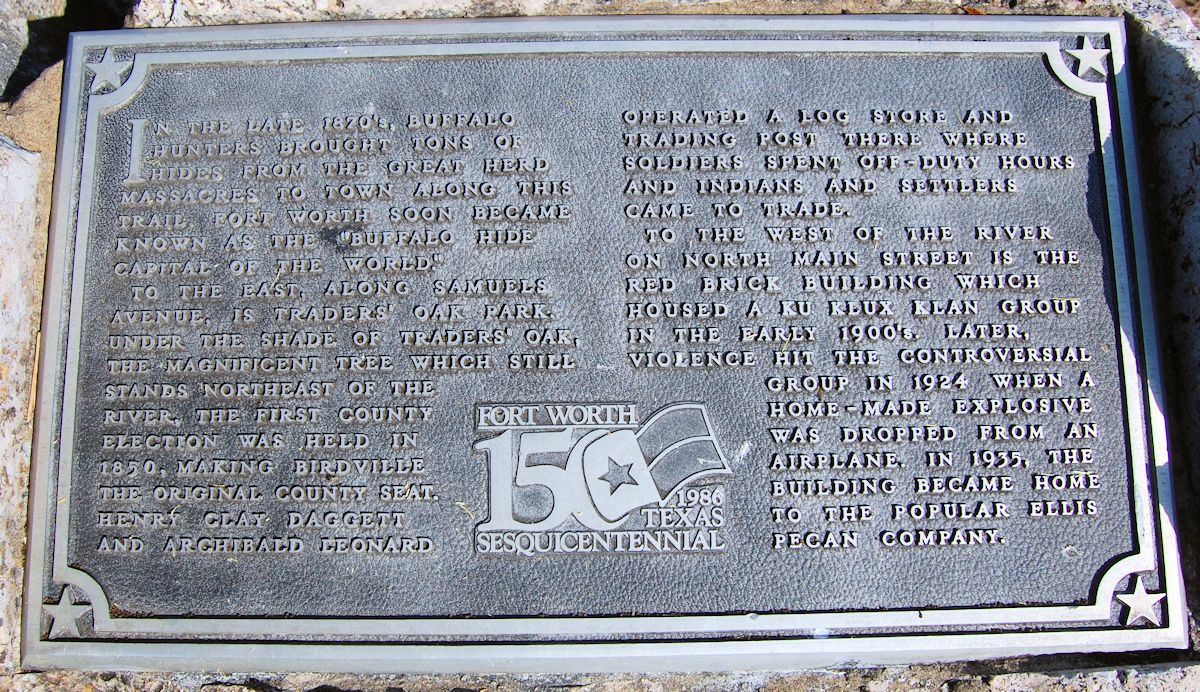 A Texas sesquicentennial marker near the Trinity River east of the hall site says “. . . violence hit the controversial group in 1924 when a home-made explosive was dropped from an airplane.” But Fort Worth historian Dr. Richard Selcer says the fire was caused by a fault in the building’s electrical system.
A Texas sesquicentennial marker near the Trinity River east of the hall site says “. . . violence hit the controversial group in 1924 when a home-made explosive was dropped from an airplane.” But Fort Worth historian Dr. Richard Selcer says the fire was caused by a fault in the building’s electrical system.
 Here’s a history mystery. Some out-of-town newspapers printed an unattributed story saying “another fire of incendiary origin destroyed a branch Ku Klux auditorium about one mile outside [Fort Worth]” “on the West Side.” “Both fires were preceded by terrific explosions.” “Firemen found Hall No. 11 a mass of flames when they arrived. The second hall was valued at $100,000. It, too, was destroyed.”
Here’s a history mystery. Some out-of-town newspapers printed an unattributed story saying “another fire of incendiary origin destroyed a branch Ku Klux auditorium about one mile outside [Fort Worth]” “on the West Side.” “Both fires were preceded by terrific explosions.” “Firemen found Hall No. 11 a mass of flames when they arrived. The second hall was valued at $100,000. It, too, was destroyed.”
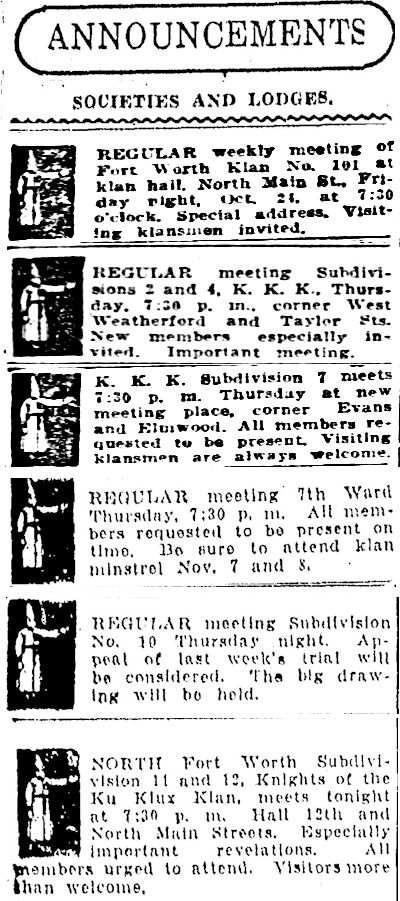
The main Klan lodge in Fort Worth was Klavern no. 101, but the Fort Worth Klan had several subdivisions around town. Subdivisions apparently were numbered according to the city ward in which they were located. For example, Klan subdivisions no. 2 and 4 met downtown, where the Second and Fourth wards were. Subdivision no. 7 met at Evans and Elmwood streets, which was in the Seventh Ward. And there was a subdivision no. 11, but it apparently was on the North Side (as was the Eleventh Ward). Regardless, I have found no local reporting about a second Klan hall fire that night.
 After the main Klan hall burned, J. Frank Norris of First Baptist Church—himself controversial—agreed to let the Fort Worth Klan stage its minstrel show in the church auditorium.
After the main Klan hall burned, J. Frank Norris of First Baptist Church—himself controversial—agreed to let the Fort Worth Klan stage its minstrel show in the church auditorium.
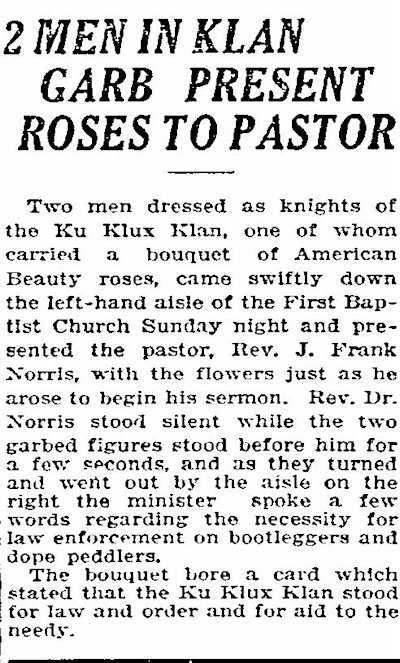 The Handbook of Texas says that Norris “openly supported the Ku Klux Klan.” During a church service on the Sunday before Valentine’s Day in 1922, “2 men in Klan garb” had presented Norris with a bouquet of roses. Clip is from the February 13 Star-Telegram.
The Handbook of Texas says that Norris “openly supported the Ku Klux Klan.” During a church service on the Sunday before Valentine’s Day in 1922, “2 men in Klan garb” had presented Norris with a bouquet of roses. Clip is from the February 13 Star-Telegram.
 And after Norris killed D. E. Chipps in 1926, Lloyd P. Bloodworth of Poly, grand dragon of the Texas Klan, met with Norris and offered Klan support. Clip is from the July 23, 1926 Dallas Morning News.
And after Norris killed D. E. Chipps in 1926, Lloyd P. Bloodworth of Poly, grand dragon of the Texas Klan, met with Norris and offered Klan support. Clip is from the July 23, 1926 Dallas Morning News.
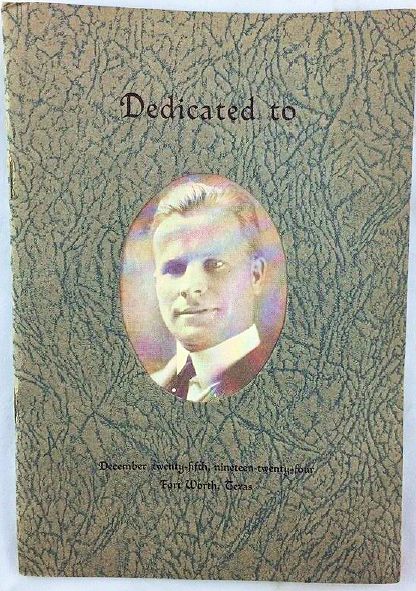 Just six weeks after that fire on November 6, 1924, Fort Worth’s Klavern no. 101 held a double celebration: On December 26 the Klan celebrated the first eighteen months of the leadership of Julian C. Hyer and plans to rebuild its burned lodge hall. To mark the celebration, the Klan had a commemorative program printed. The program was dedicated to Hyer, who is pictured on the cover.
Just six weeks after that fire on November 6, 1924, Fort Worth’s Klavern no. 101 held a double celebration: On December 26 the Klan celebrated the first eighteen months of the leadership of Julian C. Hyer and plans to rebuild its burned lodge hall. To mark the celebration, the Klan had a commemorative program printed. The program was dedicated to Hyer, who is pictured on the cover.
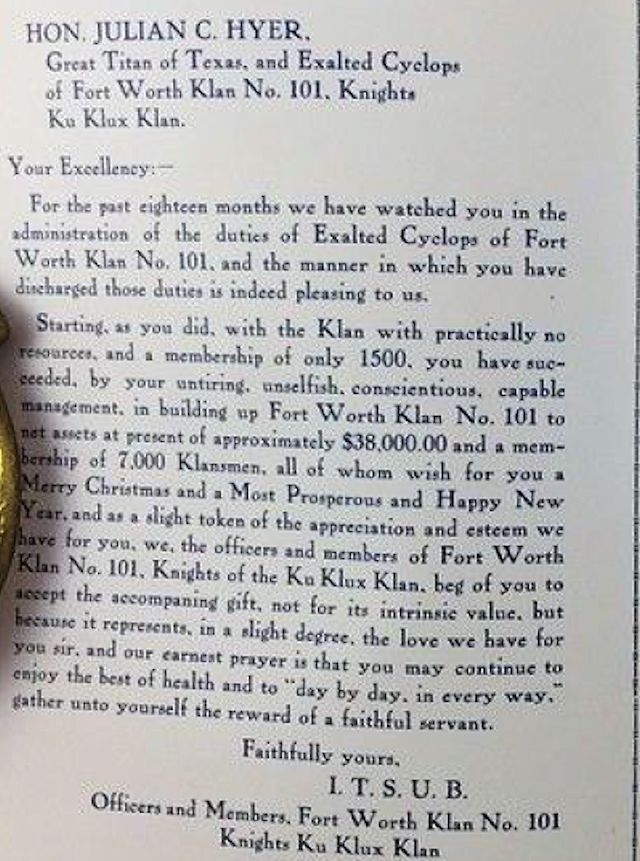 Hyer held the highest Klan office in Texas (great titan) and in the Fort Worth chapter (exalted cyclops). The dedication says the Fort Worth lodge had seven thousand members. Oh, and “I.T.S.U.B.” is “in the Sacred Unfailing Being,” a reference to God.
Hyer held the highest Klan office in Texas (great titan) and in the Fort Worth chapter (exalted cyclops). The dedication says the Fort Worth lodge had seven thousand members. Oh, and “I.T.S.U.B.” is “in the Sacred Unfailing Being,” a reference to God.
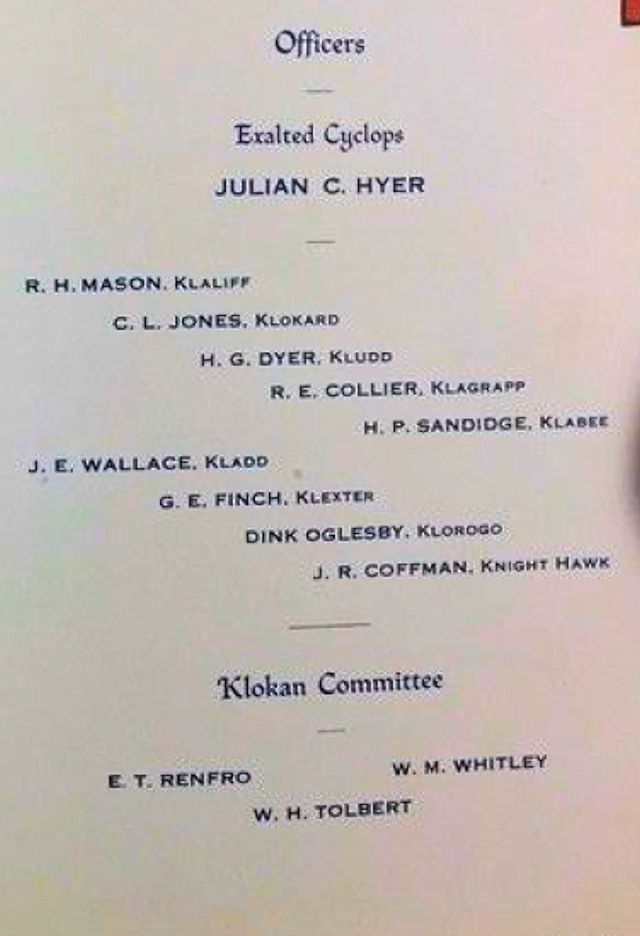
Klan terminology:
klaliff vice president
klokard lecturer
kludd chaplain
klagrapp secretary
klabee treasurer
kladd conductor in charge of initiating new members
klexter outer guard
klarogo inner guard, sergeant-at-arms
knight hawk courier
klokan advisory board
A quick perusal of Klan members listed elsewhere in the program finds candymaker Hugh Pangburn and J. M. (Star) Williams, who would be county auditor for twenty-eight years.
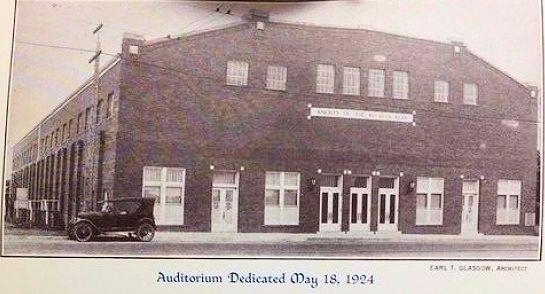
The original hall before the fire.
 One month after the fire.
One month after the fire.
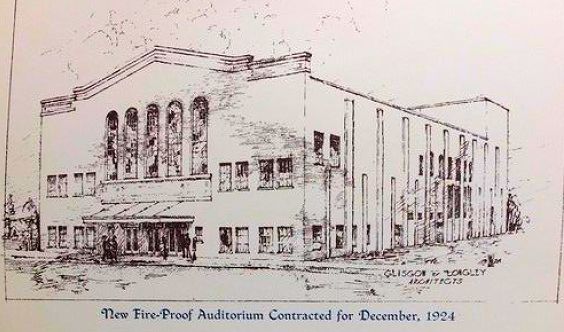
The new hall was designed by the firm of architect Earl Glasgow, a member of Klavern no. 101.
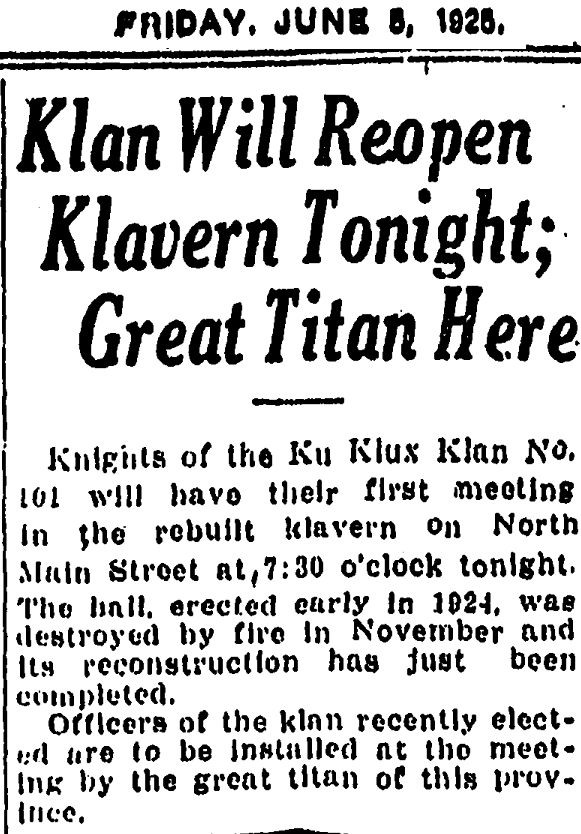 Klavern no. 101 opened its new hall on June 5, 1925.
Klavern no. 101 opened its new hall on June 5, 1925.
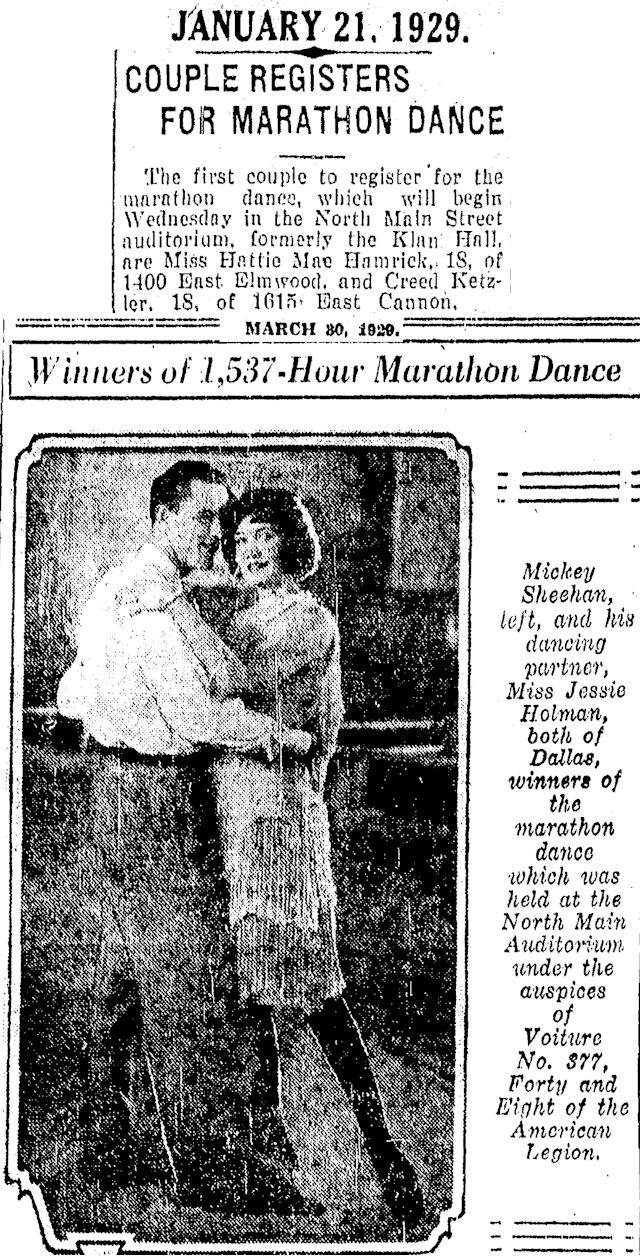 But by 1927 Klan membership was dwindling; the Fort Worth lodge sold its building to the Leonard brothers to use as a warehouse. But by 1929 the building was called “North Main Street Auditorium.” Dance marathons were held there.
But by 1927 Klan membership was dwindling; the Fort Worth lodge sold its building to the Leonard brothers to use as a warehouse. But by 1929 the building was called “North Main Street Auditorium.” Dance marathons were held there.
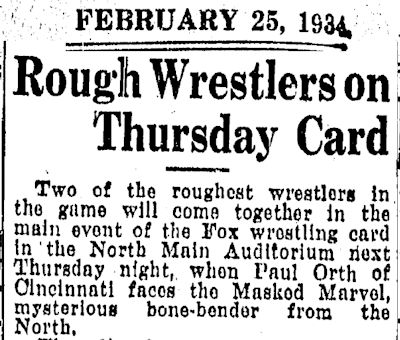 In the 1930s couples were still clinching in the old Klan hall—but now the couples were wrestlers.
In the 1930s couples were still clinching in the old Klan hall—but now the couples were wrestlers.
In 1946 the building was bought by Ellis Pecan Company. Today the building, at age ninety-six, has been vacant almost thirty years, its doors padlocked, some windows boarded, others with broken panes. But the building’s large windows on the south wall let plenty of light into a place where hooded men once waited for dark:
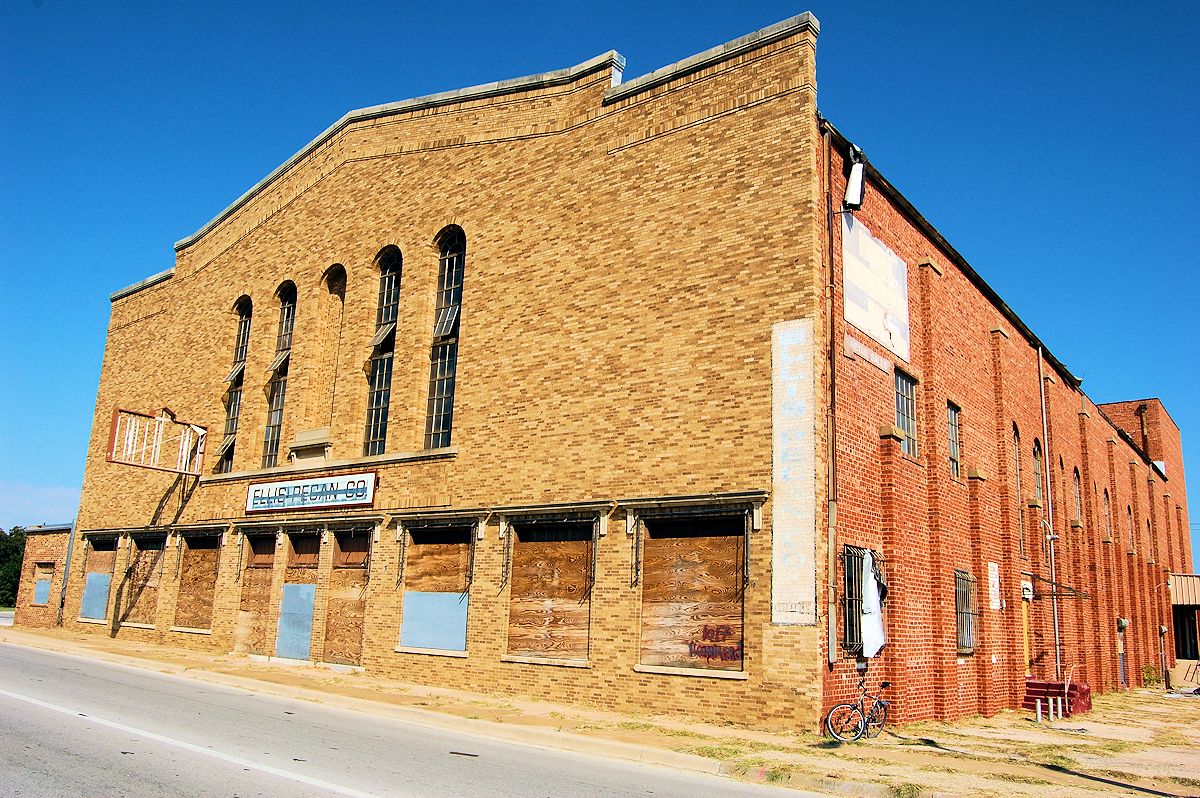
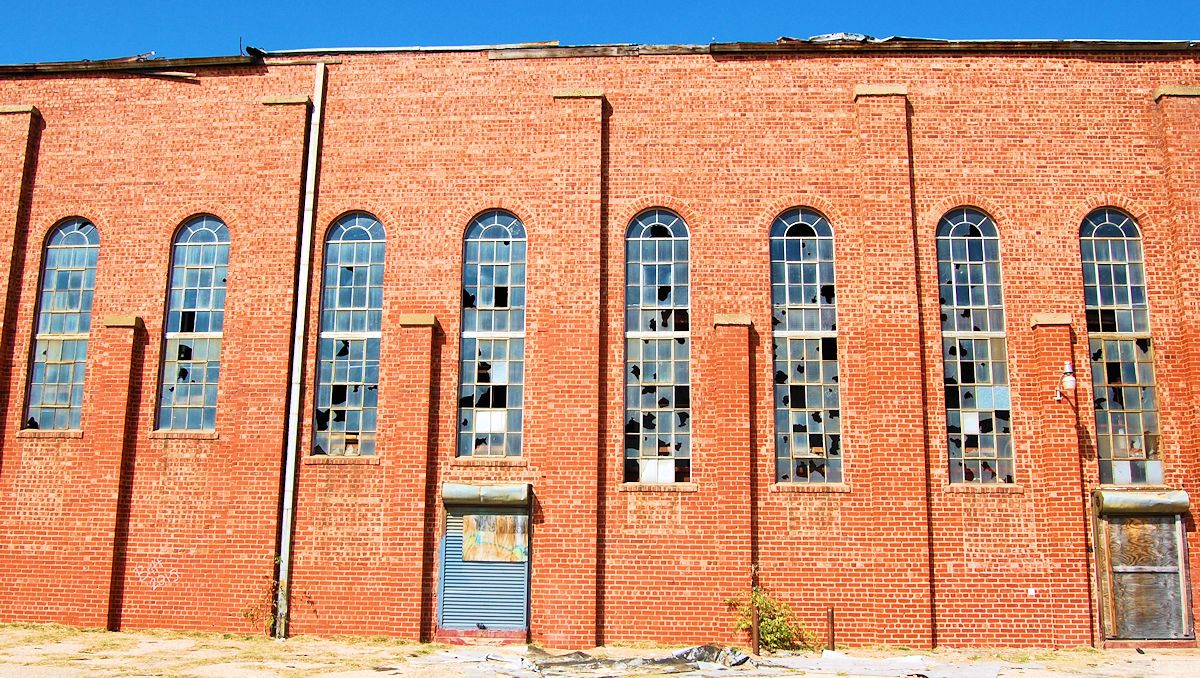 Some more views of the former home of Ku Klux Klan lodge no. 101:
Some more views of the former home of Ku Klux Klan lodge no. 101:
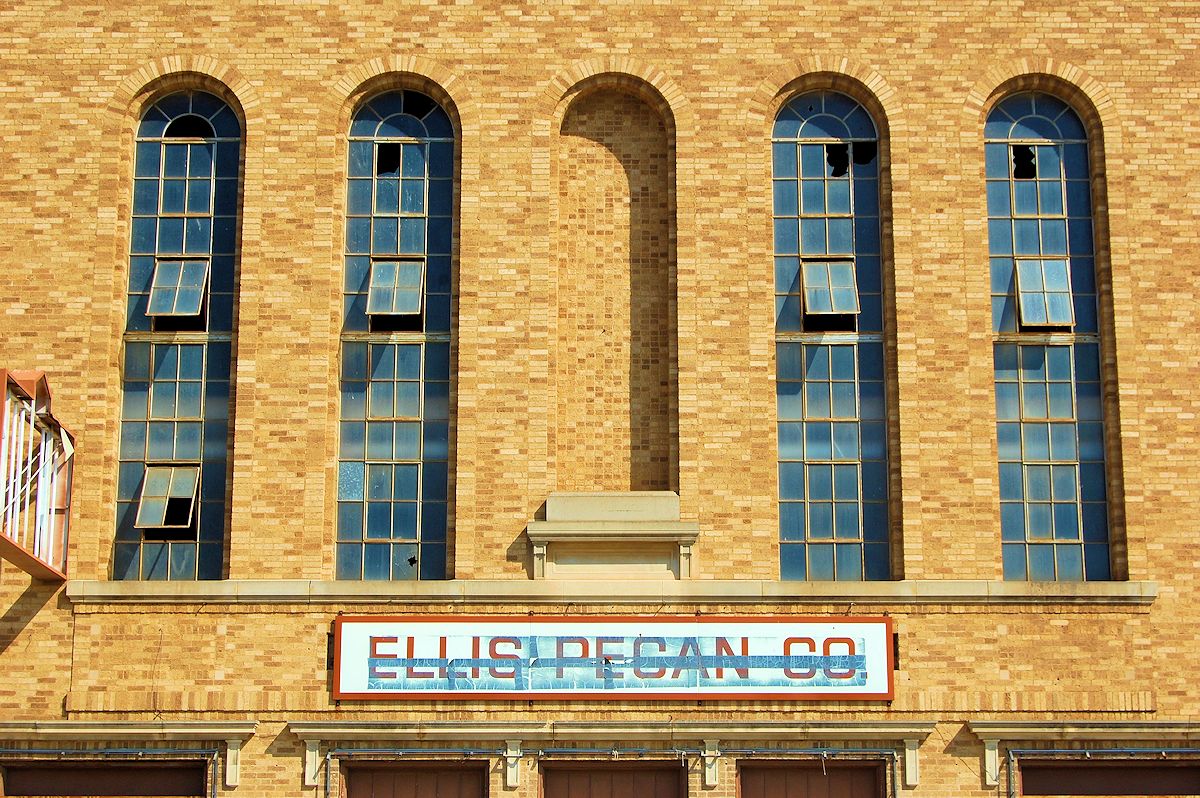



In 2022 a group of arts and racial justice organizations bought the building to convert it into the Fred Rouse Center and Museum for Arts and Community Healing.
(Thanks to retired Fort Worth police sergeant and historian Kevin Foster for his help.)
Related posts:
Verbatim: “I’se Bo’n in Slavetime” (Part 2)
Christmas 1921: “Southern Trees Bear a Strange Fruit”
That Old House on Foard Street (Part 1): The Klan
The Dallas chapter of the women of the KKK at Flashback: Dallas.






Pingback: Koalisi membeli bekas markas KKK di Fort Worth untuk menciptakan seni komunitas dan pusat penyembuhan
Do you by chance still have those photos? I would be curious to see them.
Thank you for visiting this site. Unfortunately the author, Mike Nichols, has passed away and we are working on a solution on how best to preserve it.
My mom was a boarding student at All Saints Convent and Girls, 2115 Belle Avenue, in the ’20s when a contingent of the Klan came one night, burned a cross at the front of the building, chanted some anti-Catholic rhetoric, made some noisy threats and left without damaging the building or hurting anyone, though they scared the nuns and girls who boarded there. The school was several miles from the Klan headquarters. It’s a story my mom told from time to time about life on the North Side. The property is now the site of Masonic Lodge 942.
The fact that the Klan was not just anti-African American but also anti-Catholic is often overlooked, I think.
A very good friend of mine was a supervisor/ maintenance man at Ellis pecan up until closure.
From what he told me Mr.Ellis sold the business when he was old and retiring. The business was bough by another shelling company with poor management and put the business out of operations in the mid-late 1990s.
I was able to visit before its closure, he gave me a tour inside of the building, I will say there is unique and impressive architecture inside. You can see the massive roof beams from inside, the front half is multi story while the rest is a open floorplan. He also said to me that the Klan would parade up Main St. and go past the old hall up until the late 1970s, he showed me pictures he would take from the roof of the building of the parades.
There is also some detailed gold commemorative Klansman coins made to “remember the bombing” of the building from 1924. On the coin is a side view of a Klansman on horseback and the burnt hall with smoke on the other. He had two of the coins but I suspect there are more out there.
It is a impressive building inside and out, I’m not sure if there is another building like it.
Hopefully someone will adopt this building and open it to the public.
Do you by chance still have those photos? I would be curious to see them.
The “Order of the Red Cross” mentioned in your article is not a fraternal society, but is just a degree conferred by the Masonic Knights Templar. The announcement in the newspaper that you cite is for Southside Commandery of the Knights Templar. Neither the Knights Templar nor the Masons have anything to do with the Ku Klux Klan. It’s a shame that the newspaper put all their meeting announcements together.
Thank you, Mr. Normand. I have clarified the passage regarding the Order of the Red Cross and the Masons.
Re my previous comment on status of the building: discovered Transform-1021 N. Main’s Facebook page. Bravo!
Here is the URL: Transform 1021 N Main - Fort Worth.
Glad to have found this well-documented article on the 1920s Klan in Fort Worth. Don’t leave us hanging — it is now June 19, 2020, is the building still standing? Thanks much.
Thank you. The building was still standing as of June 6.
Do you know if the Star-Telgram took any editoril position on the Klan?
Good question, Barry. I don’t recall seeing a single editorial comment in my digging. Jerry’s Amon also offers no clues.
Pingback: A Christmas with crosses, but no love: When the Klan marched in Fort Worth - Misterele robei albe
Pingback: The Dallas Chapter of the Women of the Ku Klux Klan — 1920s | Flashback : Dallas
Funny you should mention it.
Miriam ( often seen incorrectly as Mariam ) Beck was my great great grandmother. She was mother to Gen. Nathan Bedford Forrest and an Ashkenazi. There was one remaining photo of her that I remember from childhood. My grandmother ( granddaughter of Joseph Luxton ) was amazed at her height. Something close to 6’4″. My great grandfather, William Luxton was Forrest’s youngest half brother.
The earliest incarnation of the KKK was antebellum and had no real political application. Forrest and his boy buddies had no lack of horses, whiskey and ideas for pranking the neighborhoods. The Luxton daughters ( my grandmothers generation) would spend hours talking about their illustrious family but they got real quiet when my mother reminded them that Miriam Beck was a German Jew.
There was a Star Telegram interview with my Great Grandfather in 1963 or 64 that I found on an ancestry site but I can’t locate it now.( Some of these sites are like the Batcave ). I think he may have referenced his brothers feelings about the KKK that he disavowed toward the end of his life. The common take on it is that Forrest was trying to change. The family take on it was that the organization had changed. Either way, he did order every man, woman and child executed at Fort Pillow.
I don’t imagine the KKK Charitable donations extended to the AME church…
[woeful chuckle]
Fascinating story. The differences between the Klan of the back then and what we know about it now are really interesting. I heard a few short mentions of the Klan from my father when I was growing up. They were short brief comments about the Klan activities when he was a boy in the 1920’s but he never went into details.
Thanks, Wiley. Fort Worth was reflective of the state/South at the time. I read hundreds of news clips. Local Klans seemed to be forming in Texas almost daily in 1921.